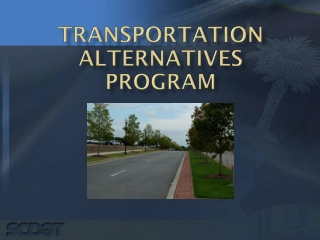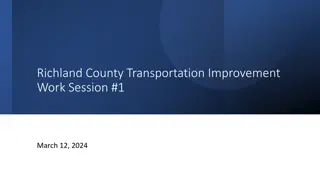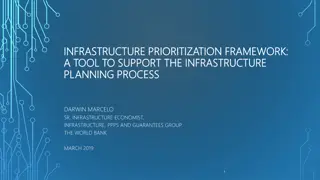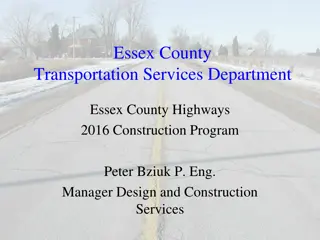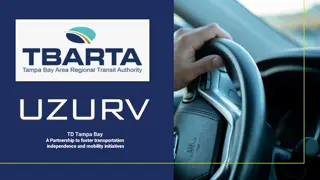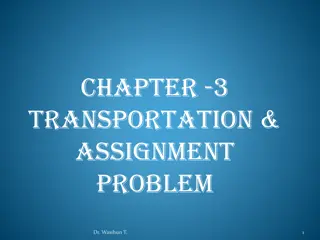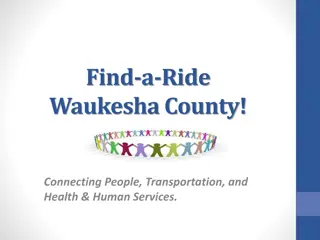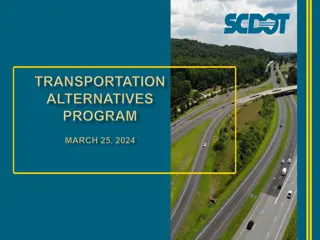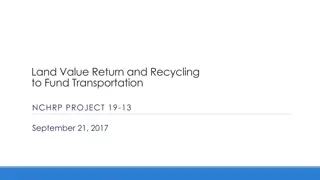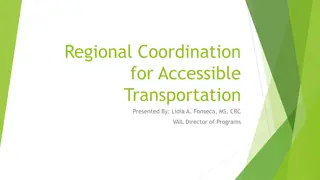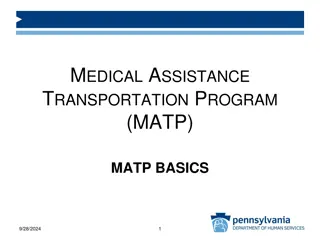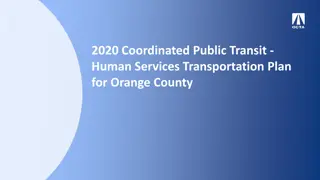Transportation Infrastructure Initiatives in Dauphin County
The County and State Transportation Infrastructure Initiatives in Dauphin County include the PennDOT Bridge Bundling Program, Dauphin County Infrastructure Bank, PennDOT Agility Program, and Next Generation Transit Revitalization Investment Districts. The Bridge Bundling Program aims to save time and costs by bundling the replacement or rehabilitation of locally owned bridges with state-owned projects, offering contribution reductions for local government participation, and showcasing successful pilot projects in Washington, Luzerne, and Blair counties. Additionally, the Dauphin County Infrastructure Bank provides financing solutions for key transportation infrastructure projects within the county.
Download Presentation

Please find below an Image/Link to download the presentation.
The content on the website is provided AS IS for your information and personal use only. It may not be sold, licensed, or shared on other websites without obtaining consent from the author.If you encounter any issues during the download, it is possible that the publisher has removed the file from their server.
You are allowed to download the files provided on this website for personal or commercial use, subject to the condition that they are used lawfully. All files are the property of their respective owners.
The content on the website is provided AS IS for your information and personal use only. It may not be sold, licensed, or shared on other websites without obtaining consent from the author.
E N D
Presentation Transcript
COUNTY AND STATE TRANSPORTATION INFRASTRUCTURE INITIATIVES NACo Transportation Steering Committee July 11, 2014
Overview PennDOT Bridge Bundling Program Dauphin County Infrastructure Bank PennDOT Agility Program PennDOT Next Generation Transit Revitalization Investment Districts
Bridge Bundling Objective PennDOT will bundle the replacement or rehabilitation of locally owned bridges with state-owned bridge projects. Multiple bridges to be replaced or rehabilitated as a single project
Bridge Bundling The program is intended to save time and costs Single engineer, single general contractor Utilizing similar designs Create an economy of scale in design and construction and project management
Bridge Bundling PennDOT will annually develop two lists of eligible bridges List developed using PennDOT NBIS Database: State, county, municipal Preliminary List: 60 Days for locals to agree Final List: 90 Days for locals to execute agreement
Bridge Bundling Local government participating in program eligible for contribution reduction up to 100% Local government refusing to participate will be responsible for 30% of the non-Federal share of the future costs for the local bridge being replaced or rehabilitated
Bridge Bundling Pilot: Washington, Luzerne, Blair 41 bridges Refurbish deck, repair superstructure, replace, remove Engineering: 25% to 50% savings Construction: 5% to 15% savings Time spent: Reduce from 7 to 2 years County cost: $0.00
DCIB The Dauphin County Infrastructure Bank (DCIB) is a financing solution that to supports key transportation infrastructure projects within Dauphin County PA
DCIB Need: Municipal-sponsored projects are in need of financing options with more flexible terms. Infrastructure projects can stall or be delayed due to lack of administrative/project management experience. Access to capital would benefit developer-driven transportation improvement projects and associated economic development.
DCIB Funding: The DCIB awards low-interest loans that leverage other local, and state funding resources Dauphin County liquid fuels tax receipts Pennsylvania Infrastructure Bank
DCIB Eligible projects include: - Bridges - Parking - Highway - Paving - Sidewalks - Signalization - Trail Improvements Eligible applicants include: Municipalities Developers (in partnership with sponsoring municipality) - Intersections - Storm water
DCIB Municipal Advantages Low-interest loan program that can may leverage other funding sources Streamlined approval process and financing terms Access to administrative and project management services
DCIB Developer Advantages: Overcome current challenge of double bonding for PIB Access to capital Low interest rates may be more competitive than commercial lending
DCIB Project Delivery Advantages Turnkey Options Dauphin County can complete all aspects of design, construction and project delivery on behalf of the applicant. Or An applicant can submit a qualified design professional for approval to complete the design. The County will deliver the project from bidding to completion.
PennDOT Agility Program Overview Provides for an exchange of services between PennDOT and local government Initiated in 1997 Share human resources, equipment and knowledge Give-give, win-win
PennDOT Agility Program Structure of the Exchanges Agreement 5-year agreement Work Plan Defines services to be exchanged and value Estimated dates for completion
PennDOT Agility Program Procedure PennDOT works with partner to identify scope of work & costs Coordinates with AFSCME on draft work plan Work Begins PennDOT & partner document completed work Upon completion, financial analysis is conducted and work plan is closed
PennDOT Agility Program Project Examples
PennDOT Next Generation Next Generation: A fresh review of PennDOT s policies, processes, procedures, and programs Examine functions and create new efficiencies Refresh and advance business practices and technology Create a culture of continuous improvement
PennDOT Next Generation Objectives: Diminish recurring cost of services better use of taxpayer money Become a better business partner Be a better employer to attract and retain quality employees Be a national leader in research and new products Improve the public s confidence
PennDOT Next Generation Five Distinct Initiatives: PennDOT Next Generation Projects: Engage PennDOT management and staff to refresh and advance business practices and technology. Mapping the Future: Coordination among PennDOT, the Turnpike Commission (PTC), the Department of Conservation and Natural Resource (DCNR), and other agencies to save resources and avoid duplicating efforts. Modernization Initiatives: Delivering on the Transportation Funding Advisory Commission s and department s modernization recommendations. State Transportation Innovation Council: A public/private/institutional approach to adopt and cultivate innovative technologies and techniques to expedite project delivery. IdeaLink: Bottom-up approach that empowers all employees to submit innovative ideas to improve workplace safety and enhance operations.
PennDOT Next Generation Resources: www.moderndot.pa.gov: Home page and Efficiencies Report The E-PennDOT Digest: Articles on Next Generation initiatives and projects. Local Technical Assistance Program Newsletter: Provides information on innovative project delivery for local governments and business partners.
TRID Transit Revitalization Investment Act of 2004: District-based tax increment financing mechanism to capture increases in property values to pay for needed improvements. Unlike tax-increment financing (TIF), it does not require that there be a finding of blight Explicit emphases on transit and transit oriented development (TOD)
TRID In operation: Incremental tax revenues (up to 20 years) are used to finance transit station improvements, sidewalk, bikeway and road connections into the community, and other infrastructure enhancements. Spark business and residential development by providing convenience of an enhanced transit system.
TRID Process: Municipality or county conducts TRID planning study of market conditions, development opportunities, needed transit improvements and financing plan. Dept. of Community & Economic Development funding available for study (up to $75K) Designate management entity to administer Designate TRID
Resources CCAP www.pacounties.org; dhill@pacounties.org PennDOT www.dot.state.pa.us Dauphin County www.dauphinc.org Dept. of Community & Economic Development www.newpa.com


